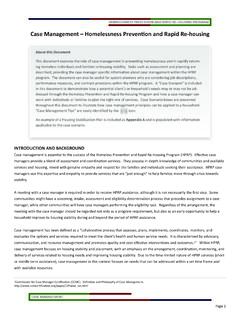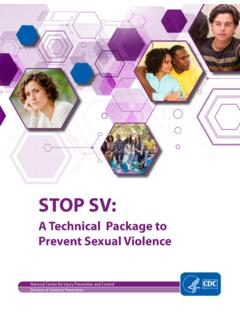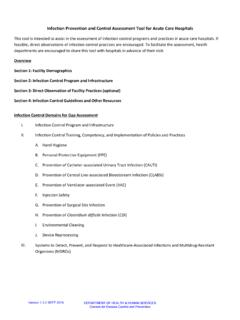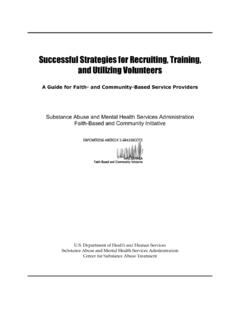Transcription of SCHOOL-BASED VIOLENCE PREVENTION - UNICEF
1 ASCHOOL- based VIOLENCE PREVENTIONA practical handbookSchool- based VIOLENCE PREVENTION : a practical handbookISBN 978-92-4-151554-2 World Health Organization 2019 Some rights reserved. This work is available under the Creative Commons Attribution-NonCommercial-ShareAlike IGO licence (CC BY-NC-SA IGO; ).Under the terms of this licence, you may copy, redistribute and adapt the work for non-commercial purposes, provided the work is appropriately cited, as indicated below. In any use of this work, there should be no suggestion that WHO endorses any specific organization, products or services. The use of the WHO logo is not permitted. If you adapt the work, then you must license your work under the same or equivalent Creative Commons licence.
2 If you create a translation of this work, you should add the following disclaimer along with the suggested citation: This translation was not created by the World Health Organization (WHO). WHO is not responsible for the content or accuracy of this translation. The original English edition shall be the binding and authentic edition .Any mediation relating to disputes arising under the licence shall be conducted in accordance with the mediation rules of the World Intellectual Property citation. SCHOOL-BASED VIOLENCE PREVENTION : a practical handbook. Geneva: World Health Organization; 2019. Licence: CC BY-NC-SA (CIP) data. CIP data are available at , rights and licensing.
3 To purchase WHO publications, see To submit requests for commercial use and queries on rights and licensing, see materials. If you wish to reuse material from this work that is attributed to a third party, such as tables, figures or images, it is your responsibility to determine whether permission is needed for that reuse and to obtain permission from the copyright holder. The risk of claims resulting from infringement of any third-party-owned component in the work rests solely with the disclaimers. The designations employed and the presentation of the material in this publication do not imply the expression of any opinion whatsoever on the part of WHO concerning the legal status of any country, territory, city or area or of its authorities, or concerning the delimitation of its frontiers or boundaries.
4 Dotted and dashed lines on maps represent approximate border lines for which there may not yet be full agreement. The mention of specific companies or of certain manufacturers products does not imply that they are endorsed or recommended by WHO in preference to others of a similar nature that are not mentioned. Errors and omissions excepted, the names of proprietary products are distinguished by initial capital reasonable precautions have been taken by WHO to verify the information contained in this publication. However, the published material is being distributed without warranty of any kind, either expressed or implied. The responsibility for the interpretation and use of the material lies with the reader.
5 In no event shall WHO be liable for damages arising from its in SwitzerlandDesign by Inis Communication year up to 1 billion children experience some form of physical, sexual or psychological VIOLENCE or neglect. Being a victim of VIOLENCE in childhood has lifelong impacts on education, health, and well-being. Exposure to VIOLENCE can lead to educational underachievement due to cognitive, emotional, and social problems. Because children who are exposed to VIOLENCE are more likely to smoke, misuse alcohol and drugs, and engage in high-risk sexual behaviour, they are also more likely to endure a range of illnesses later in life. These include depression, cardiovascular disease, diabetes, cancer and H I this reality, preventing VIOLENCE against children is squarely on the international development agenda.
6 Sustainable Development Goal (SDG) target calls for the elimination of all forms of VIOLENCE against girls, and SDG target calls for ending all forms of VIOLENCE against children. Access to education is equally prominent within the SDGs, with SDG target to build and upgrade education facilities that provide safe, non-violent learning environments for all. Many efforts are underway that would help to achieve these goals. These activities take place in various settings. Schools have been identified as one important setting for conducting VIOLENCE PREVENTION efforts. Therefore, in early 2019, with support from several of its affiliated organizations, the Global Partnership to End VIOLENCE against Children launched the Safe to Learn initiative focused specifically on ending VIOLENCE against children in schools.
7 The activities promoted as part of this initiative complement current work countries are doing to implement the evidence- based technical package INSPIRE: seven strategies for ending VIOLENCE against children. Enhancing access to education and providing life skills training through schools form one of the seven strategies. In schools, the provision of education and organized activities are themselves powerful protection against VIOLENCE . In addition, it is in these settings that opportunities arise to shape attitudes and norms about the acceptability of VIOLENCE , alcohol and drug use, the carrying of weapons onto school grounds and other risks.
8 In turn, preventing VIOLENCE in the broader society can directly benefit the core aim of schools to educate children, foster high-quality lifelong learning, and empower leaners to be responsible global citizens. This new resource: SCHOOL-BASED VIOLENCE PREVENTION : a practical handbook, is about schools, education and VIOLENCE PREVENTION . It provides guidance for school officials and education authorities on how schools can embed VIOLENCE PREVENTION within their routine activities and across the points of interaction schools provide with children, parents and other community members. If implemented, the handbook will contribute much to helping achieve the SDGs and other global health and development the importance of SCHOOL-BASED VIOLENCE PREVENTION , this handbook was produced by WHO, in collaboration with UNESCO and UNICEF .
9 We invite you to join us in acting to increase the number and effectiveness of SCHOOL-BASED VIOLENCE PREVENTION activities to ensure the safety, well-being and happiness of children and their parents and caregivers KrugDirector, Department for Management of Noncommunicable Diseases, Disability, VIOLENCE and Injury PreventioniAcknowledgementsThis handbook was written by Sara Wood, Karen Hughes and Mark Bellis from the WHO Collaborating Centre on Investment for Health and Well-being at Public Health Wales and Berit Kieselbach from the World Health Organization. Substantial contributions were made by Christophe Cornu, Jenelle Babb and Joanna Herat (UNESCO), Stephen Blight, Songha Chae, Masue Suzuki, Rocio Aznar Daban, Anna Azaryeva Valente, Clarice da Silva e Paula, and Theresa Kilbane ( UNICEF ), Alexander Butchart, Stephanie Burrows (WHO) and Khadijah document was edited by Ruth Morton (Plain English Campaign) and proof-read by Amanda Germanio (WHO).
10 Claire Scheurer (WHO) provided administrative document has also benefitted greatly from comments and suggestions provided by the following peer reviewers: Cathy Ward, Sujata Bordoloi, Soraya Lester, Jenny Parkes, Angela Nakafeero and Sarah Lindstrom conceptual foundations for this document were outlined in a December 2015 expert consultation on SCHOOL-BASED VIOLENCE PREVENTION . Consultation participants included: Sujata Bordoloi, Patrick Burton, Karen Devries, Michael Dunne, Manuel Eisner, Khadija Fancy, Erika Fraser, Joanna Herat, Berit Kieselbach, Theresa Kilbane Ha Le Hai, Soraya Lester, Ersilia Mensini, Dipak Naker, Jenny Parkes, Francisco Quesney, Christina Salmivalli, Catherine Ward and Sara Know VIOLENCE in Childhood Initiative, in particular Ramya Subrahmanian and Patrick Burton, provided extensive support in convening the first expert meeting and sharing evidence from the research work of Know 2 Section 1: Getting started: Develop leadership, school policies and coordination methods 12 Section 2.















